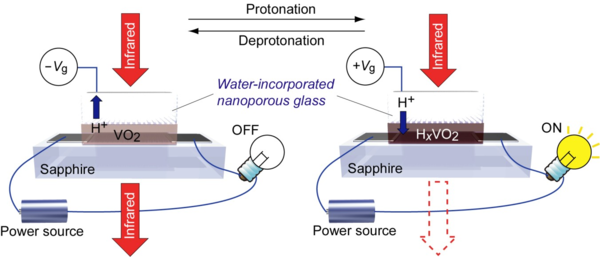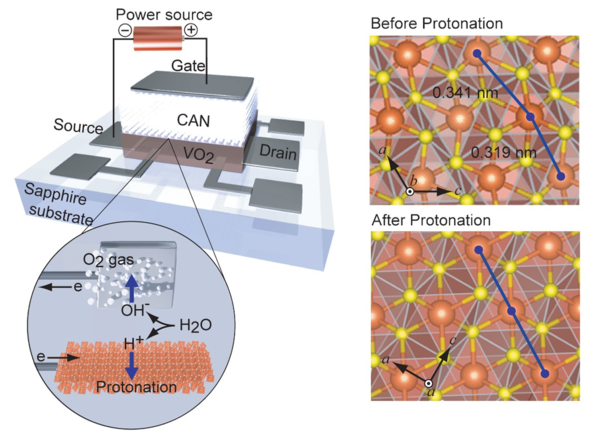Research Institute for Electronic Science at Hokkaido University successfully developed an all-solid-state thin-film device with the ability to control both of infrared-light transmittance and electric current at the same time (Figure 1).
Electrochromic materials are essential to develop electronic devices which control both of light transmittance and electrical conductivity at the same time. Tungsten trioxide (WO3), a representative electrochromic material, has been applied for color-switching windows in airplane. However, the electrochromism of WO3 reduces the transmittance of visible-light along with that of infrared (IR) and thus it is impossible for WO3 to control only the IR transmittance while keeping the visible-light transparency.
This research team focused on vanadium dioxide (VO2), which is a classically well-known thermochromic material. VO2 shows an abrupt change of the optical transmission only in the infrared region along with the insulator-to-metal transition when heated to the transition temperature of 68°C. Non-doped VO2 is an insulator and transparent for visible-light and IR, but the protonated VO2 (HxVO2) is a metal and opaque to IR while maintaining visible-light transparency. Therefore, protonation and deprotonation of VO2 can develop light-control glasses with functionality of switching only IR, but protonation of VO2 needs imperative high-temperature heat treatment in hydrogen gas and electrochemical reaction through electrolysis of an aqueous solution, which have been unsuited for practical purposes.
Here we have demonstrated solid-state protonation and deprotonation of VO2 thin film at RT by using a thin film transistor (TFT) structure with a gate insulator of water-infiltrated nano-porous glass (CAN) [Ref. 1], which works like a sponge and automatically adsorbs water vapor in air (Figure 2). A positive gate bias application induces water electrolysis in the solid CAN gate insulator, and produced electro-active H+ ions are used to protonate the VO2 channel layer. As a result, sheet resistance and absolute value of thermopower significantly decreased, i.e. the electronic state changed from insulator to metal by protonation of VO2 at RT. The protonation was clearly accompanied by the structural change from monoclinic VO2 to tetragonal HxVO2 phase. On the other hand, negative gate bias application induced deporotonation of VO2, where the metallic state recovered to insulating one. These results prove that we have succeeded to demonstrate the fabrication of all-solid-state thin-film device, which doesn’t require the high-temperatureand liquid electrolyte.
The reversible protonation and deporotonation of VO2 under an applied voltage at RT offer a new route to all-solid-state smart windows; e.g. the electro-optical device that can realize the on-demand shielding of transmittance of IR light, which disturbs the control of ambient temperature, and electrical switching of air conditioner.
This research was conducted in collaboration with Prof. Takayoshi Katase, Prof. Hiromichi Ohta (Laboratory of Functional Thin Film Materials, RIES), and Prof. Tetsuya Tohei, Prof. Yuichi Ikuhara (Institute of Engineering Innovation, The University of Tokyo). A part of this work was supported by JSPS KAKENHI for Scientific Research A (25246023), Young Scientists A (15H05543), and Scientific Research on Innovative Areas (25106007). This paper was published in Advanced Electronic Materials (electronic version) on June 1st, 2015.
| Authors: | Takayoshi Katase*, Kenji Endo, Tetsuya Tohei, Yuichi Ikuhara, and Hiromichi Ohta* |
| Title: | Room-temperature-protonation-driven on-demand metal-insulator conversion of a transition metal oxide |
| DOI: | 10.1002/aelm.201500063 |

Schematic illustration of an all-solid-state thin-film device with the ability to control both of IR transmittance and electric current at the same time. Positive gate voltage application produces protonated VO2 film (HxVO2), where IR is shielded and electric current pass through the channel layer (ON state). Meanwhile, Negative gate voltage application induces deprotonation, where IR is transmitted and electric current is prevented to flow the channel layer (OFF state).

Schematic illustration of VO2 thin-film transistor with a gate insulator of water-infiltrated nano-porous glass (CAN). Gate voltage application induces water-electrolysis in the solid CAN film and the produced H+ ion can be electrochemically introduced into VO2 thin film. Right figure represents the crystal-structure change from monoclinic structure of insulating VO2 to tetragonal one of metallic HxVO2.










